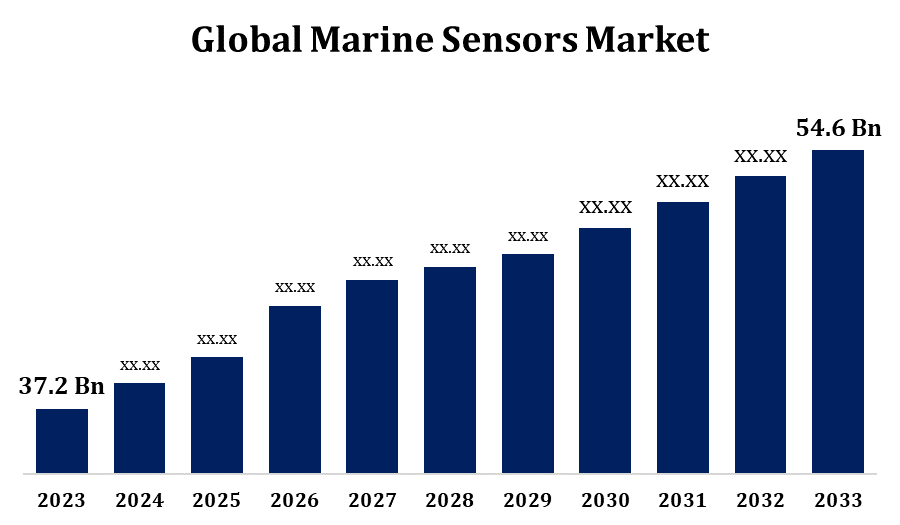Global Marine Sensors Market Size To Worth USD 54.6 Billion by 2033 | CAGR of 3.91%
Category: Aerospace & DefenseGlobal Marine Sensors Market worth $54.6 billion by 2033
According to a research report published by Spherical Insights & Consulting, the Global Marine Sensors Market Size to grow from USD 37.2 billion in 2023 to USD 54.6 billion by 2033, at a Compound Annual Growth Rate (CAGR) of 3.91% during the forecast period.

Get more details on this report -
Browse 333 market data Tables and 47 Figures spread through 220 Pages and in-depth TOC on" Global Marine Sensors Market Size, Share, and COVID-19 Impact Analysis, By Type (Acoustic Sensors, Magnetic Sensors, Sonars, Pressure Sensors, Temperature Sensors, Flow and Level Sensors, and Others), By Platform (Military and Defense and Commercial), By Application (Intelligence & Reconnaissance, Communication & Navigation, Electronic Warfare, Target Recognition, Surveillance & Monitoring, and Others), and By Region (North America, Europe, Asia-Pacific, Latin America, Middle East, and Africa), Analysis and Forecast 2023 - 2033." Get Detailed Report Description Here: https://www.sphericalinsights.com/reports/marine-sensors-market
The marine sensors market is experiencing rapid growth, driven by the increasing demand for advanced technologies across sectors like oil and gas, shipping, defense, and environmental monitoring. These sensors play a vital role in measuring parameters such as temperature, pressure, salinity, depth, and water quality, providing essential data for navigation, resource management, and environmental protection. Technological advancements, including the integration of IoT and wireless communication, are enabling the development of more efficient and cost-effective sensors. Furthermore, growing awareness of marine pollution and the need for sustainable practices are fueling market expansion. The rising adoption of autonomous underwater vehicles (AUVs) and unmanned systems is also contributing to sensor demand. As sensor technologies continue to evolve, the market is set to expand further with new innovations and applications.
Marine Sensors Market Value Chain Analysis
The marine sensors market value chain consists of several critical stages, beginning with research and development (R&D) focused on creating innovative sensor technologies. Manufacturers design and produce sensors that measure parameters such as temperature, salinity, and pressure. Suppliers provide essential raw materials like semiconductors and other components required for sensor assembly. After manufacturing, sensors are distributed through various channels, including direct sales, resellers, and distributors. These sensors are then integrated into systems used across sectors such as defense, oil and gas, shipping, and environmental monitoring. Service providers ensure optimal performance by offering installation, maintenance, and technical support. End-users, including government bodies, research institutions, and private companies, apply marine sensors in areas such as underwater exploration, navigation, and pollution monitoring. The entire value chain is shaped by technological advancements, regulatory standards, and environmental factors.
Marine Sensors Market Opportunity Analysis
The marine sensors market offers substantial growth opportunities, driven by several key factors. The increasing global focus on environmental monitoring and marine conservation is particularly boosting demand for sensors used in tracking pollution, water quality, and ecosystem health. Additionally, the growing need for underwater exploration in sectors like offshore oil and gas, renewable energy, and deep-sea research is fueling the demand for advanced sensors. Technological innovations, such as the integration of the Internet of Things (IoT) and autonomous systems like unmanned underwater vehicles, are opening new avenues for sensor functionality. Investments in smart shipping solutions by governments and organizations to enhance efficiency and reduce environmental impact are further driving sensor adoption. Rising awareness about climate change and marine pollution is also spurring the need for accurate, real-time data collection, contributing to the market's expansion across various industries.
The rising demand for advanced sensors across various industries is expected to significantly drive the growth of the marine sensors market. Sectors such as oil and gas, shipping, defense, and environmental monitoring rely on accurate and reliable data for safety, efficiency, and sustainability. Advanced sensors are crucial in measuring vital parameters like temperature, salinity, pressure, and water quality, supporting informed decision-making and enhanced operational performance. Additionally, the growing use of technologies like the Internet of Things (IoT) and autonomous underwater vehicles (AUVs) is boosting the need for more advanced marine sensors. As environmental concerns and the need for marine conservation grow, the demand for real-time monitoring and precise data is becoming more critical. This increase in demand is expected to drive significant market growth in the coming years.
The marine sensors market faces several challenges that could hinder its growth. A major issue is the high cost of advanced sensors and their associated technologies, which may limit adoption, especially among small-scale operators and in developing regions. The harsh underwater environment also presents challenges for sensor durability and reliability, requiring robust designs to withstand pressure, corrosion, and extreme conditions. Integrating sensors into existing systems can be complex, often requiring customization and specialized expertise. Additionally, varying regulatory standards and certifications for marine sensors across regions can complicate global market access. The rapid pace of technological advancements demands continuous innovation, prompting companies to heavily invest in research and development to remain competitive. Lastly, concerns over data security, particularly in remote or sensitive environments, add another layer of complexity to the market.
Insights by Type
The flow and level sensors segment accounted for the largest market share over the forecast period 2023 to 2033. These sensors are essential for ensuring operational efficiency and safety in industries like shipping, oil and gas, and offshore renewable energy. In shipping, flow and level sensors accurately measure fuel and ballast water levels, helping prevent spills and ensuring compliance with regulations. The growing use of these sensors in environmental monitoring, particularly for tracking water levels and flow rates in oceans, rivers, and lakes, is further driving the segment’s growth. Moreover, advancements in sensor technology, including wireless communication and IoT integration, are enhancing the functionality of flow and level sensors, boosting their adoption in marine systems worldwide.
Insights by Platform
The military & defense segment accounted for the largest market share over the forecast period 2023 to 2033. Sensors like sonar, radar, and underwater acoustic systems are vital for defense applications, providing enhanced situational awareness and the ability to detect submarines, mines, and other underwater threats. The growing emphasis on national security and border protection has led to greater investments in maritime defense technologies. Furthermore, the use of unmanned underwater vehicles (UUVs) and autonomous systems in military operations is fueling the adoption of marine sensors for tasks such as reconnaissance, intelligence gathering, and surveillance. As defense budgets increase and technology advances, the demand for more advanced, durable, and precise marine sensors in military applications is expected to grow globally.
Insights by Application
The surveillance & monitoring segment accounted for the largest market share over the forecast period 2023 to 2033. The growth of the marine sensors market is driven by the increasing demand for real-time data in environmental protection, maritime security, and resource management. These sensors play a crucial role in monitoring water quality, pollution levels, and marine ecosystems, aiding efforts to protect biodiversity and ensure compliance with environmental regulations. In maritime security, sensors are used for surveillance, helping to detect unauthorized vessels, threats, and illegal activities in coastal areas. The expansion of offshore oil and gas exploration and the rise of offshore renewable energy projects are also fueling the demand for advanced monitoring solutions. Furthermore, integrating Internet of Things (IoT) technology into surveillance systems enhances sensor performance, enabling more effective data collection and analysis. As environmental concerns and the need for maritime security grow, this segment's expansion is expected to continue.
Insights by Region

Get more details on this report -
North America is anticipated to dominate the Marine Sensors Market from 2023 to 2033. The United States is a key player in the marine sensors market, driven by high demand across sectors such as defense, oil and gas exploration, shipping, and environmental monitoring. The increasing need for real-time data on water quality, pollution levels, and ecosystem health is driving the adoption of marine sensors in both public and private sectors. Additionally, the growing emphasis on sustainable practices, including offshore renewable energy sources like wind farms, is further stimulating market growth. The presence of leading sensor manufacturers and a robust research and development ecosystem in North America supports this expansion. With its strategic coastal location and focus on environmental monitoring, the region's demand for marine sensors is expected to remain strong.
Asia Pacific is witnessing the fastest market growth between 2023 to 2033. Japan, South Korea, and India are key contributors to the marine sensors market, with substantial investments in offshore oil and gas exploration, shipping, and defense. The region's growing focus on marine conservation and pollution monitoring is driving the demand for marine sensors, especially in environmental research and monitoring. Additionally, the rise of smart shipping technologies and the increasing use of autonomous underwater vehicles (AUVs) are further boosting market growth. Asia-Pacific's extensive coastline and rich marine biodiversity underscore the need for advanced monitoring systems. Furthermore, government initiatives aimed at enhancing maritime infrastructure and promoting sustainable practices are expected to drive continued demand for marine sensors across a wide range of industries.
Recent Market Developments
- In February 2024, Thales signed a USD 2.3 billion contract to upgrade the Royal Navy's sonar and sensor systems, emphasizing enhanced lifetime availability and resilience.
Major players in the market
- Honeywell International Inc. (US)
- Eaton Corporation (Ireland)
- TE Connectivity (Switzerland)
- Garmin Ltd. (US)
- Curtiss Wright (US)
Market Segmentation
- This study forecasts revenue at global, regional, and country levels from 2023 to 2033.
Marine Sensors Market, Type Analysis
- Acoustic Sensors
- Magnetic Sensors
- Sonars
- Pressure Sensors
- Temperature Sensors
- Flow and Level Sensors
- Others
Marine Sensors Market, Platform Analysis
- Military and Defense
- Commercial
Marine Sensors Market, Application Analysis
- Intelligence & Reconnaissance
- Communication & Navigation
- Electronic Warfare
- Target Recognition
- Surveillance & Monitoring
- Others
Marine Sensors Market, Regional Analysis
- North America
- US
- Canada
- Mexico
- Europe
- Germany
- Uk
- France
- Italy
- Spain
- Russia
- Rest of Europe
- Asia Pacific
- China
- Japan
- India
- South Korea
- Australia
- Rest of Asia Pacific
- South America
- Brazil
- Argentina
- Rest of South America
- Middle East & Africa
- UAE
- Saudi Arabia
- Qatar
- South Africa
- Rest of the Middle East & Africa
About the Spherical Insights & Consulting
Spherical Insights & Consulting is a market research and consulting firm which provides actionable market research study, quantitative forecasting and trends analysis provides forward-looking insight especially designed for decision makers and aids ROI.
Which is catering to different industry such as financial sectors, industrial sectors, government organizations, universities, non-profits and corporations. The company's mission is to work with businesses to achieve business objectives and maintain strategic improvements.
CONTACT US:
For More Information on Your Target Market, Please Contact Us Below:
Phone: +1 303 800 4326 (the U.S.)
Phone: +91 90289 24100 (APAC)
Email: inquiry@sphericalinsights.com, sales@sphericalinsights.com
Contact Us: https://www.sphericalinsights.com/contact-us
Need help to buy this report?